PLEASE NOTE: Because of concerns over the escalating COVID-19 virus, FMCA’s 101st International Convention and RV Expo, scheduled for March 26-29, 2020, has been cancelled.
Here’s a small taste of what FMCA members will find in the Arizona city set to host the association’s 101st International Convention and RV Expo in March.
By Maggie Kielpinski
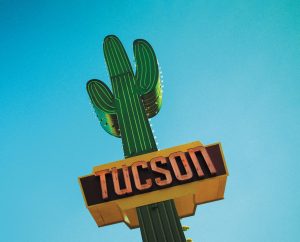
The Gateway Saguaro is an illuminated art installation that marks the state’s first divided highway.
I’ve been in love with the American Southwest ever since I can remember. Thanks to the movies, I’ve ridden the range with John Wayne and Glenn Ford, through that iconic landscape of towering red buttes and under the branching arms of giant saguaros. I have gazed at ocotillos and chollas, silhouetted at sunset against dusky purple hills like paper cutouts in a shadowbox. For me, Arizona meant Wyatt Earp and Doc Holliday and gunfights. A bit simplistic, yes, but my reality for many years.
Personally experiencing it is even better. A few years ago my husband and I began to explore the desert lands, and later we spent weeks there escaping the snowy winters of northern California, where we live. There is a timelessness and an ease about Tucson that makes me feel at home.
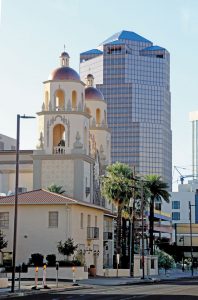
St. Augustine Cathedral
Tucson sits at the eastern edge of the Sonoran Desert, in a wide valley made verdant by both summer and winter rains. The green haze of palo verde trees spreads across the valley floor, while prickly ocotillo and cholla, and the iconic saguaro, create a fantasy landscape replicated in gardens across the world. While the winter climate here is idyllic, when temperatures blaze in the summer, one always can escape to the sky islands of alpine woodlands in the violet mountains that ring the valley.
A long and diverse history awaits here for those who like to investigate. Hohokam Indians farmed the land for centuries, diverting water from the Santa Cruz River through an ingenious system of channels to crops. With the Spanish came the Jesuit missionary Father Eusebio Kino, who established Mission San Xavier del Bac in 1692 on Indian land. Almost 100 years later, the Franciscans built the magnificent Baroque church that still stands today.
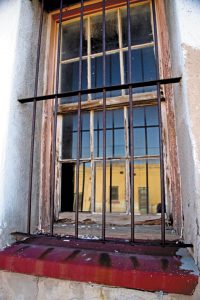
Tucson character is seen along the streets of the Barrio Viejo.
Heritage Food
Much more recently, in 2015, the city’s admirable food offerings earned it recognition as a UNESCO Creative City of Gastronomy. It’s one of two such cities in the United States. (The other is San Antonio, Texas.)
What’s more, Visit Tucson, the local tourism authority, promises it lists the best 23 miles of Mexican food anywhere (see its website for details). Thus, I felt compelled to conduct serious research into this matter by plugging address after address into my GPS. Then I set off on my culinary adventure.
I drove down Twelfth Avenue in South Tucson through traditional neighborhoods where taquerias and food trucks alternated with transmission shops and ramshackle strip malls; along Speedway Boulevard and Fort Lowell Road; through barrios and other areas. I ate classic Sonoran Mexican food at El Charro Café, one of the oldest eateries in town. At one of the newest, Penca, I tucked into tacos of fresh masa filled with braised tongue and beef cheek, and washed them down with Flor de Azalea, the restaurant’s potent blend of Sonoran brandy, banana, oatmeal milk, chamomile, and turmeric. From the most humble to the very finest, each eatery had its own take on heritage food.
I drove to Mission San Xavier del Bac, just south of the city, through green fields of corn, squash, and beans growing in the rich alluvial soil of the flood plains of the Santa Cruz River, as they have for thousands of years. I passed the Tohono O’odham community gardens that had mesquite flour for sale and, in season, such rarities as saguaro seeds and cholla buds.
Tucson produces a vast amount of heritage food. The local nonprofit Native Seed/Search has worked hard to establish a seed bank with more than 2,000 varieties of crops adapted to arid lands. Around here, you’ll find a farmers market somewhere in the city every day of the week selling cactus jellies and jams; wild chilis; mesquite honey; figs; pomegranates; quinces; pecans; range-fed beef; and red and white wines made from mission grapes introduced by Spanish explorers.

On El Presidio plaza, this work of art depicts the day in the 1840s when the Mormon battalion came through Tucson.
Heritage Sites
While searching for local history, I learned that exploring Tucson is easy. Drive a towing or towed vehicle into town and choose from several parking garages and lots throughout the city. To get around after you’re parked, the town has dozens of bike-share stations, and a Sun Link streetcar line. I boarded the streetcar early one morning in the Mercado District and breezed through town, hopping off at Sixth Avenue for a cup of coffee at the Cup Café in the Hotel Congress. I boarded again, headed north along the Fourth Avenue business district, and got off at Seventh Street to stroll past retro hippie shops and tattoo parlors.
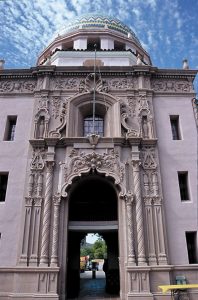
Tourists can check out the beautiful Pima County Courthouse.
Hotel Congress’ claim to fame is that a small fire broke out there in January 1934, and the evacuation led to the apprehension of two men in John Dillinger’s gang. Soon came the capture of Dillinger himself, who was renting a house elsewhere in town.
I landed at lively Main Gate Square in the heart of the University District. Pedestrian-friendly spots like this help make this college town so welcoming. The square hosts free live jazz on Friday evenings amid a variety of shopping and eating options.
At the Tucson Visitors Center near Main Gate Square, I picked up the Turquoise Trail map and headed for the Presidio Museum, located at the beginning of the Turquoise Trail. The trail is marked by a turquoise stripe on the sidewalk and leads 2.5 miles past downtown sites and buildings of historical interest, all of which are described on the map. For a copy of the map, go to the Visit Tucson website.
Tucson’s European founding father was Hugh O’Connor, an Irish member of the Spanish army. In those days, Catholics in Ireland, at least those who could afford it, left their homeland because of religious persecution and took jobs elsewhere. O’Connor rose to the rank of major with the Spanish army and built the Presidio in 1775 to mark the northern frontier of the Spanish empire in North America. The fort also protected settlers from ever-present Apache raids.
During the Mexican-American War of 1846-48, the small band of Mexicans and civilians at the fort, in the face of the advancing U.S. Army’s Mormon battalion, fled for their lives. Needlessly, it turned out, for after helping themselves to the food stores and bartering with the local Pima Indians for fruit and vegetables, the Mormons moved on to San Diego. They had bigger fish to fry. Within 10 years, with the Gadsden Purchase, Tucson became American territory.
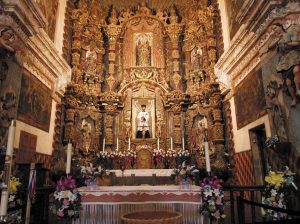
The altar area of Mission San Xavier del Bac, which is open to the public.
Today the original Presidio is gone, but visitors at the smaller reproduction stand on part of the original property. Inside, docent-led tours open up the times and lives of the local American Indians, fort residents, and settlers. Archaeological artifacts are displayed. Living history programs are offered occasionally (about once a month or more); one is slated for March 21, a few days prior to the FMCA convention. Check the Presidio website for tour times and details.
From the Presidio, the Turquoise Trail leads past courtyards of old Sonoran row houses now transformed into an eclectic medley of artisans’ shops; past the Pima County Courthouse and its beautiful dome of turquoise tile; and across the Garces footbridge that spans Congress Avenue with its massive statue of Pancho Villa astride his horse.
I called the walk my three-hour magical history tour. It led me through the Barrio Viejo (“old neighborhood”) past the Sosa-Carrillo-Fremont House, the home of territorial governor John Fremont; Teatro Carmen, a theater that entertained with traveling troupes from Spain and Mexico at the turn of the 20th Century; El Tiradito, a small shrine where neighbors still come to burn candles and pray; the magnificent Spanish Colonial St. Augustine Cathedral; Wyatt Earp and “Doc” Holliday in bronze statues at the historic railroad depot; and back to the Hotel Congress.
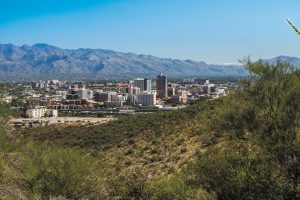
With a little more than 500,000 residents, Tucson is Arizona’s second-most populous city, behind Phoenix.
In between the historic stops is the never-ending streetscape of colorful Sonoran row houses with their Zen-like cactus gardens, which provide endless fodder for my obsessive picture-taking. Lunch break midway was a cold drink and an enormous chimichanga at the El Minuto Café next to the Tiradito shrine.
I was reluctant to leave the next day; I felt I had barely scratched the surface in discovering Tucson’s charms. History and food are just two facets of the city. It’s cutting-edge, but in a low-key sort of way. It celebrates the past while welcoming the new, so it continually adds more layers to its story.
More To Explore*
Pima Air & Space Museum: See more than 350 historical aircraft on 80 acres. Three of the six indoor exhibit hangars are dedicated to World War II.
Exclusive bus tours of the nearby Aerospace Maintenance and Regeneration Group (AMARG), commonly called the Boneyard, are conducted only through the Pima Air & Space Museum. The Boneyard is where used military aircraft go to be recycled or destroyed. Museum and Boneyard: www.pimaair.org
Titan Missile Museum: This Arizona treasure offers one-hour guided tours via reservations only. The planning is said to be well worth it, as tours include a simulated Titan missile launch! You must be able to climb stairs to take this tour. Located approximately 25 miles south of Tucson in Sahuarita. www.titanmissilemuseum.org
Tucson Botanical Garden: Meander down pathways through a barrio garden, a xeriscape garden, and a Zen garden. Wind up at the butterfly pavilion and immerse yourself in butterfly magic. www.tucsonbotanical.org
Mission San Xavier del Bac: Built on the site of a mission founded by Father Eusebio Kino in 1692, this National Historic Landmark is considered the finest example of Spanish Colonial architecture in the United States. The Coyote Store on the plaza offers fine native crafts; and don’t forget to stop at the San Xavier co-op farm for seasonal heritage food. www.sanxaviermission.org
Old Tucson: This is a theme-park-type place originally built as a movie set, which is still used in film productions. Live stunt shows, comedy, musicals, a train ride, a mine tour, and more are included with admission; other activities, such as trail rides, are offered for additional fees. www.oldtucson.com
Other sites: The Franklin Auto Museum; Catalina State Park; Sabino Canyon Recreation Area; Saguaro National Park; Mount Lemmon Scenic Byway; the Tucson Museum of Art; and Reid Park Zoo. In addition, the Tucson area has more than 40 city, public, and private golf courses.
*Look in this issue of Family RVing for a story about the number-one tourist spot near Tucson: the Arizona-Sonora Desert Museum (page 58).
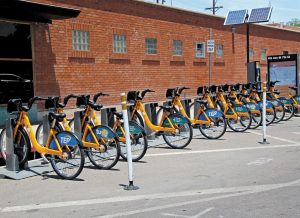
Tourists can rent a ride at one of the town’s Tugo Bike Share stations.
Further Info
Visit Tucson
811 N. Euclid Ave.
Tucson, AZ
(800) 638-8350 for Visitors Guide
www.visittucson.org
For downtown dining information and suggestions, see www.tucsonfoodie.com and www.downtowntucson.org.
For a downtown parking and streetcar map, see www.tucsonaz.gov/park-tucson/where-can-i-park-downtown.
“Sunsets + Saguaros” Convention
FMCA’s 101st International Convention and RV Expo will be held March 26-29, 2020, at the Pima County Fairgrounds in Tucson. This 640-acre facility is 20 miles southeast of downtown Tucson and easily accessed from Interstate 10. The fairgrounds has many amenities, including two dog parks; laundry and shower facilities; a dump station; an exercise trail; and much more.
Don’t miss all of the fun planned for the “Sunsets + Saguaros” convention in sunny Tucson. Register online at FMCA.com or by calling the FMCA Events Department: (800) 543-3622, (513) 474-3622.
Area Camping
Long-term camping is often the rule in winter and early spring in Arizona. However, most RV parks keep some shorter-term spaces available as well. If you are arriving early or staying later to explore Tucson, see campground listings in your RV park directory or app; and visit the Campgrounds listing in the FMCA RV Marketplace at FMCA.com and published in this issue on page 178.
For statewide RV travel information, check the Arizona State RV Travel Guide, which also has campground listings and attractions. www.azrvguide.com.
The following are FMCA commercial member campgrounds in Tucson.
Caballo Loco Ranch, C13720
14475 W. Britten Ranch Road
(alternate street address: 14475 TR Ranch Road)
Tucson, AZ 85736
(520) 449-0616
Clr.office@gmail.com
www.caballolocoranch.com
Rincon Country East RV Resort, C13399
8989 E. Escalante Road
Tucson, AZ 85730
(520) 886-8431
dcoleray@email.arizona.edu
www.rinconcountry.com
Rincon Country West RV Resort, C2739
4555 S. Mission Road
Tucson, AZ 85746
(800) 782-7275
www.rinconcountry.com

